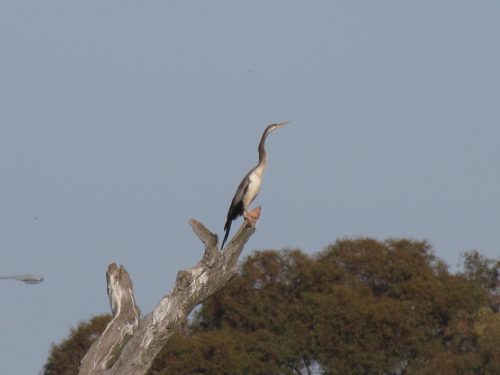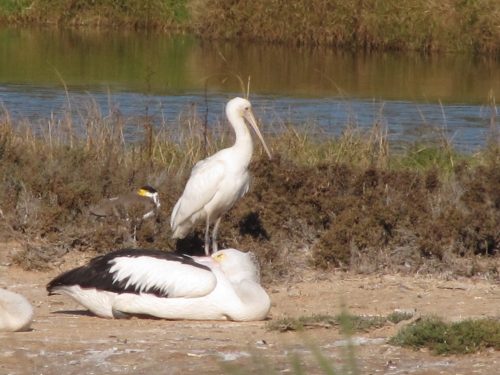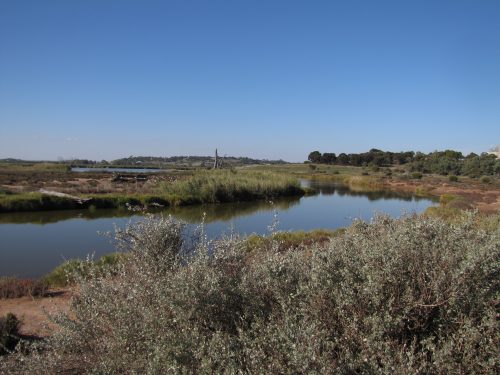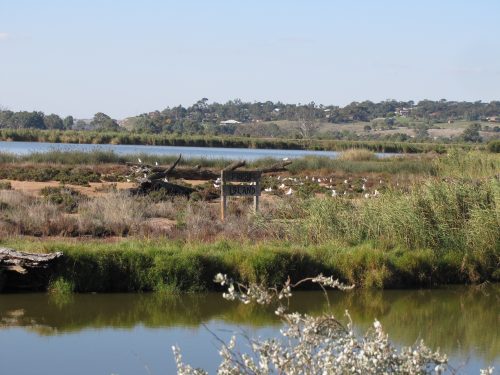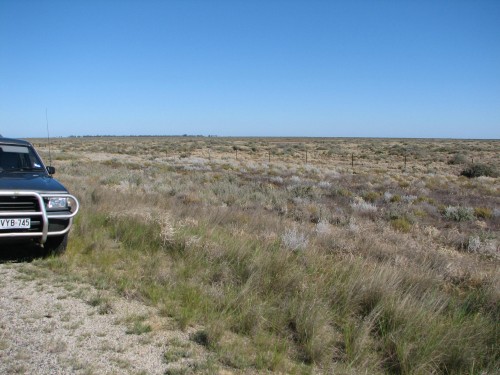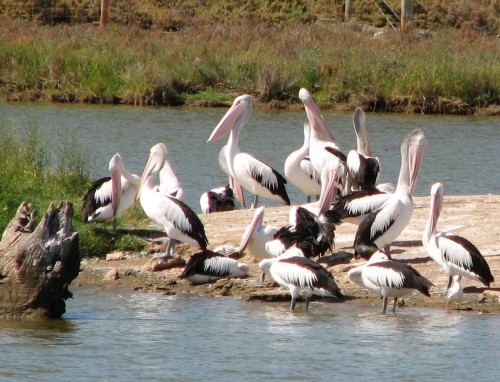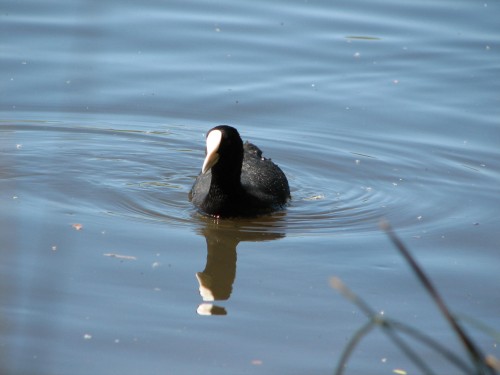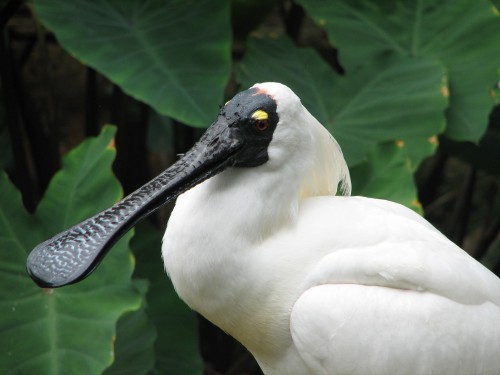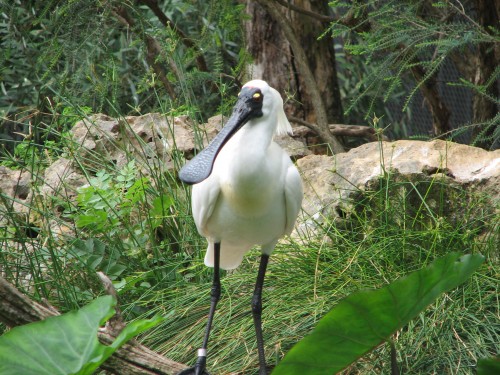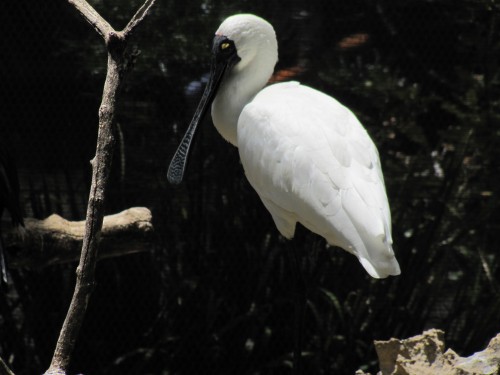Rocky Gully Wetlands, Murray Bridge
Earlier this year I spent a whole afternoon birding at various sites around my hometown of Murray Bridge here in South Australia. One of those sites was the Rocky Gully Wetlands on Mannum Road. I frequently drive past this wetland area, glancing at the lagoons as I drive, but not stopping. I need to change that and linger for a few minutes and take a much more careful note of the birds present. That action is probably safer than birding while driving, anyway.
Bush birds
On this occasion, there were plenty of birds present. Around the lagoons, there were quite a few smaller bush birds in the trees and shrubs that have been planted in the area. This included Red Wattlebirds, White-plumed Honeyeaters, Singing Honeyeaters and New Holland Honeyeaters. I heard a Grey Shrike-thrush calling and several times I heard the resident Superb Fairy-wrens twittering their soft calls to each other. Several Crested Pigeons were present and three Galahs were the only parrots seen at this location. Normally, I would expect to see Little Corellas and several kinds of Lorikeets here. They were absent on this visit.
Waterbirds
On the water of the lagoons or on the several islands I could see quite a few Grey Teal and Chestnut Teal, but interestingly, no Pacific Black Ducks which are very common in this area. A small number of Black-winged Stilts, Eurasian Coots and a solitary Purple Swamphen were seen, along with four Australian Pelicans, a White-necked Heron and a Great Egret. The egret was slowly wading in the shallows looking for a feed. It is a pity I didn’t get a good photo of this bird and its reflections in the water.
Of particular interest were the small group of both Royal and Yellow-billed Spoonbills. I always love seeing these species wherever I go birding. The most interesting sighting, however, was the count of twelve Australasian Darters. While this number is common in many parts of Australia, I have never seen so many in one spot in this region. Probably the most numerous species present were the Silver Gulls, with between 30 and 40 birds around the wetlands.
Further reading:
For each of the species mentioned in this post, I have written one or more articles about them on this site. To read them, go to the search facility in the top right-hand corner and type in the name of the species.
Newsletter:
I also invite you to subscribe to my occasional newsletter (see below the comments).
Good birding,
Trevor
Surprising waterbirds of the dry country
Dry Country
I love the dry country we have here in Australia. Most of my birding has been done in areas of Australia which have an average annual rainfall of under 250mm (10 inches). Some of this country is marginal farming country, sometimes cereals, and often sheep and cattle. I grew up on such a farm and still cherish my childhood adventures in the mallee bushland near my home.
On the road again
Earlier this week my wife and I travelled from our home in Murray Bridge, South Australia, to Sydney. We are currently staying with my son and his family. The grandchildren love having us stay with them. At ages 7 and 4 they are already showing an interest in the birds they see in their garden, and in the parks they visit. My interest has rubbed off on them.
Missing out
The car journey from home to Sydney is over 1300km, two long days of driving. In future, we think we might take three or four days to get here, stopping more frequently at the many interesting places along the way. There are many national parks, reserves, botanic gardens and bushland on this route and we just have to drive right on by, often with a groan of despair at what we might be missing.
Hay Plains
One of the places we drive through is the large rural town of Hay, located on the banks of the Murrumbidgee River. The birding along this river can be excellent. But before we get to Hay we have to pass through about 130 kilometres of the Hay Plains, a dry region consisting of few trees, much saltbush and some grassland. I find this drive to be fascinating because it often reveals odd collections of birds. On one trip we saw hundreds of Emus grazing on the low vegetation. On another trip, after heavy rain in that area, we saw thousands of ducks, mostly Australian Wood Duck and Grey Teal. They were taking advantage of the long stretches of water still lying along the edges of the highway.
Surprising Waterbirds
As we travelled along at 110kph my wife suddenly pointed out an interesting sight. It was a gathering of dozens of waterbirds: Australian Pelicans, White Ibis, Straw-necked Ibis and Yellow-billed Spoonbills. Harassing all of them from only several metres overhead was a Swamp Harrier. As we rushed by I didn’t have time to take in the presence of any other birds. I am sure that if we had had the time to stop, I would have recorded several species of ducks, perhaps coots, swamphens, egrets, herons and lapwings, cormorants, and maybe even some crakes and rails.
Irrigation
This was a very surprising collection of birds for what is essentially very dry country. The reason for their presence is explained by the presence of wide irrigation channels. The water is pumped from the nearby Murrumbidgee River into a series of channels, some of which are 5 or more metres wide. The water is then used to either flood irrigate large expanses of land, or pumped through long, overhead sprinkler systems. This area grows large amounts of hay, wheat and cotton, all irrigated from the channels. The fact that this also provides a perfect environment for numerous birds is a pleasant by-product. Further east there are large expanses of fruit orchards as well.
Further reading:
- Australian Pelicans overhead
- White Ibis at Dubbo Zoo
- Straw-necked Ibis Adelaide Zoo
- Yellow-billed Spoonbills and the birth of a birder
Royal Spoonbill
Spoonbills would have to be one of my favourite of all of the wonderful birds we have here in Australia. It was another species, the Yellow-billed Spoonbill that was , in part, responsible for me becoming a birder. I was fascinated to see one feeding in the rock pools of Chambers Gorge in the Flinders Ranges. This was in the mid 1970s. Because it is in the harsh, arid far north of South Australia, this gorge only has water intermittently.
I didn’t have a far to travel to see the bird shown in today’s photo, a Royal Spoonbill. It was taken in one of the walk through aviaries in the Adelaide Zoo, a mere hour’s drive from my home.
Royal Spoonbill, Adelaide Zoo
Australia has two species of spoonbill, the Royal Spoonbill, shown above, and the Yellow-billed Spoonbill. The latter has a special place in my birding life; you can read here about how this bird played an important part in me becoming a birder.
I love seeing either of our species of spoonbill, so they are rather special birds to me. While both species are widespread throughout suitable habitat in Australia, in my experience they are generally not encountered in large numbers anywhere, usually from one individual to three or four in the same locality. Or perhaps I’m not looking in the right places.
Beware – the hazards of birding
I went for my morning walk before breakfast today. I generally follow the same route along a side road next to our property. The birding was quite good, despite the cool, overcast conditions. It was threatening to rain and I actually felt a few drops as I walked along.
Near the end of my route where I turn around and retrace my steps home I saw a dead Brown Snake on the road. It had been reasonably warm the day before, so I guessed that was when it came to grief. Although it’s not a busy road, large trucks come long it several times a day so it’s possible that one of them ran over it.
Although it is only a few weeks into spring, the snakes are on the move – and probably hungry after their winter hibernation. Brown Snakes are relatively common around here but they tend to keep out of our way by choice, so we only ever see one or two every year, usually dead specimens like the one I saw this morning.
The photo above is of an Inland Taipan (I think I read the label correctly) taken yesterday on our family visit to the Cleland Wildlife Park near Adelaide. The Brown Snake found around here is somewhat similar in appearance. Both are quite venomous so I treat any encounter with caution.
More than once I’ve almost stepped on a snake while birding, and on one infamous occasion actually had one slither over my boot. Now that’s observing our wildlife just a little too closely.
Just so my loyal readers are not disappointed, I’ve included a photo of some birds taken yesterday.
